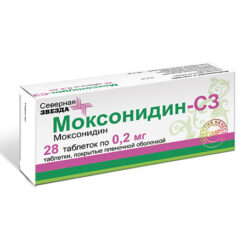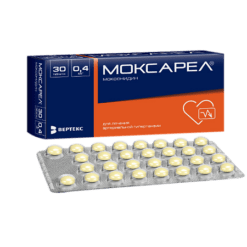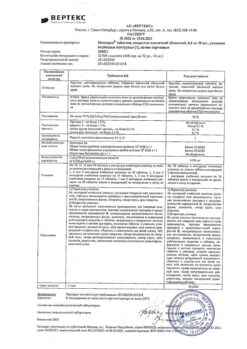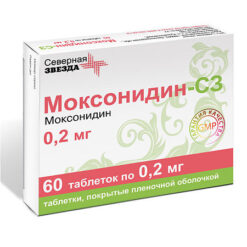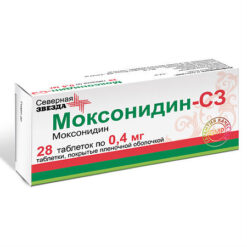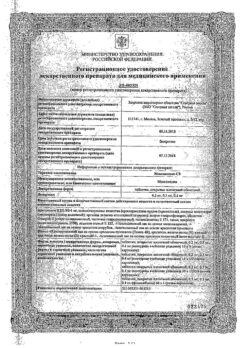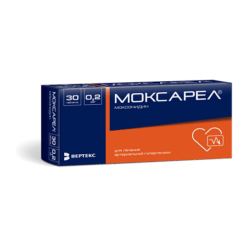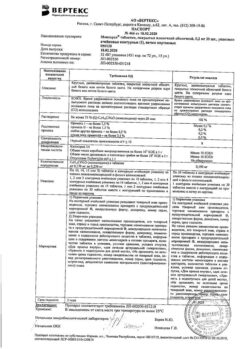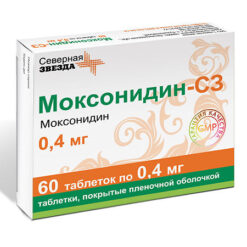No products in the cart.
Moxonidine, 0.4 mg 28 pcs
€1.00
Out of stock
(E-mail when Stock is available)
Description
Pharmacodynamics
A selective agonist of imidazoline receptors responsible for tonic and reflex control of the sympathetic nervous system (localized in the ventero-lateral part of the medulla oblongata). Reduces blood pressure (BP). Slightly binds with central alpha2-adrenoreceptors, due to the interaction with which dry mouth and sedative effect are mediated.
Decreases tissue resistance to insulin.
Impact on hemodynamics: decrease of systolic and diastolic BP with single and prolonged use of moxonidia is associated with decrease of pressor action of sympathetic system on peripheral vessels, decrease of peripheral vascular resistance, while cardiac output and heart rate (HR) do not change significantly.
Pharmacokinetics
Absorption after oral administration is 90%. The amount of absorption is not affected by food intake. Bioavailability is 88%. Binding with blood plasma proteins – 7%. Cmax in plasma is determined 30-180 min after oral administration and is 1-3 pg/ml. The volume of distribution is 1.4-3 l/kg. Passes through the blood-brain barrier.
It does not cumulate with prolonged use. The elimination half-life is 2-3 hours. Excreted by the kidneys 90% (70% – unchanged, 20% – as metabolites). No significant differences in pharmacokinetics were found in young and elderly patients.
Indications
Indications
Arterial hypertension.
Active ingredient
Active ingredient
Composition
Composition
Active substance:
moxonidine 0,2,mg,
Ancillary substances:
Microcrystalline cellulose,
Arosil A-380,
Polyvinylpyrrolidone,
/p>
magnesium stearate,
hydroxypropyl cellulose (clucel),
castor oil,
tween-80.
How to take, the dosage
How to take, the dosage
Ingestion, regardless of meals, with plenty of fluid. In most cases, the initial dose of moxonidine is 0.2 mg per day, in a single dose, preferably in the morning hours.
If the therapeutic effect is insufficient, the dose may be increased after 3 weeks of therapy to 0.4 mg per day in 2 doses or a single dose. The maximum daily dose to be divided into 2 doses (morning and evening) is 0.6 mg. The maximum single dose is 0.4 mg.
In elderly patients with normal renal function, the dosage recommendations are the same as for adult patients.
In patients with renal insufficiency (creatinine clearance 30-60 ml per minute) and patients on hemodialysis, the single dose should not exceed 0.2 mg; the maximum daily dose is 0.4 mg.
Interaction
Interaction
Moxonidine may be prescribed with thiazide diuretics and “slow” calcium channel blockers. When co-administration of moxonidine with these and other hypotensive agents there is a mutual enhancement of moxonidine action.
When prescribing moxonidine with hydrochlorothiazide, glibenclamide (gliburide) or digoxin there is no pharmacokinetic interaction.
Tricyclic antidepressants may decrease the effectiveness of centrally acting antihypertensive agents.
Beta-adrenoblockers increase bradycardia, the severity of the negative ino- and dromotropic effects of moxonidine.
Moxynidine moderately enhances impaired cognitive ability in patients taking lorazepam.
Prescribing moxonidine with benzodiazepines may be accompanied by an increase in the sedative effect of the latter.
There is no pharmacodynamic interaction when prescribing moxonidine with moclobemide.
Special Instructions
Special Instructions
If it is necessary to withdraw beta-adrenoblockers and moxonidine simultaneously, the beta-adrenoblockers should be withdrawn first and moxonidine only after several days.
Tricyclic antidepressants should not be prescribed simultaneously with moxonidine. Alcohol consumption is excluded during treatment. During treatment, regular monitoring of blood pressure, heart rate and ECG is necessary.
Moxonidine may be prescribed with thiazide diuretics, ACE inhibitors and slow calcium channel blockers.
Moxonidine should be stopped gradually.
Contraindications
Contraindications
High sensitivity to the drug components, sinus node weakness syndrome, sinoatrial and atrioventricular block of II and III degree, expressed bradycardia (heart rate less than 50 beats/min).), chronic heart failure of III and IV class (according to NYHA classification), angioneurotic edema in anamnesis, unstable angina pectoris, severe liver failure, chronic renal insufficiency (creatinine clearance less than 30 ml/min, creatinine more than 160 μmol/l), age under 18 years (effectiveness and safety have not been established), pregnancy and lactation, concomitant use with tricyclic antidepressants.
With caution: Parkinson’s disease (severe form), epilepsy, glaucoma, depression, “intermittent” claudication, Raynaud’s disease, atrioventricular block of degree I, chronic renal insufficiency (creatinine clearance greater than 30, but less than 60 ml/min.), cerebrovascular disease, after myocardial infarction, chronic heart failure class I and II, severe hepatic insufficiency – due to lack of experience of use, hemodialysis.
Side effects
Side effects
Especially at the beginning of therapy the most frequent adverse reactions were: dry mouth, headache, dizziness, asthenia, peripheral edema, allergic reactions, nausea, constipation, drowsiness.
The intensity and frequency of their manifestations decrease with repeated administration. Anorexia, parotid gland pain, urinary retention or incontinence, dry eye, orthostatic hypotension, Raynaud’s syndrome, endocrine disorders, cholelithiasis have been reported.
Overdose
Overdose
Symptoms: headache, sedation, drowsiness, excessive BP decrease, dizziness, general weakness, bradycardia, dry mouth, vomiting, fatigue, stomach pain. Short-term elevation of BP, tachycardia, and hyperglycemia are also potentially possible.
Treatment: symptomatic. Gastric lavage (immediately after ingestion), administration of activated charcoal and laxatives, symptomatic therapy. In case of a decrease in blood pressure it is recommended to restore the volume of circulating blood by administration of fluids. Bradycardia may be controlled with atropine.
Alpha-adrenoreceptor antagonists may reduce or eliminate transient arterial hypertension in moxonidine overdose. Idazoxan (an imidazoline antagonist) is given as a specific antidote.
Pregnancy use
Pregnancy use
There is no clinical evidence of adverse effect on pregnancy. However, caution should be exercised when prescribing moxonidine to pregnant women.
Breastfeeding should be stopped during treatment (penetrates into breast milk).
Similarities
Similarities
Additional information
| Shelf life | 2 years |
|---|---|
| Conditions of storage | In a dry, light-protected place. |
| Manufacturer | FGUP Pharmzaschita NPC, Russia |
| Medication form | pills |
| Brand | FGUP Pharmzaschita NPC |
Other forms…
Related products
Buy Moxonidine, 0.4 mg 28 pcs with delivery to USA, UK, Europe and over 120 other countries.


